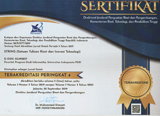Perbandingan Kinerja Algoritma K-Nearest Neighbors (K-NN) Dan Decision Tree dalam Deteksi Paket Malis pada Jaringan
(1)
(2) Universitas Nasional
(3) Universitas Nasional
(*) Corresponding Author
Abstract
This research aims to classify malicious packet data and compare the performance of two algorithms, namely K-Nearest Neighbor (K-NN) and Decision Tree (DT). The UNSW-NB15 dataset used in this study has undergone preprocessing, feature selection, and data split stages. The preprocessing stage includes data transformation and selection of relevant features to detect malicious packets. Subsequently, experiments were conducted to test various values of K in K-NN and measure accuracy, recall, precision, and F1-Score. The results show that K-NN has an accuracy of 91.54%, while DT has 92.41%. The conclusion of this research indicates that the Decision Tree (DT) algorithm performs slightly better than K-Nearest Neighbor (K-NN) in detecting malicious packets. Therefore, in selecting an algorithm for network security detection, it is important to consider the specific needs and goals of the research as well as the characteristics of the data used.
Keywords
Full Text:
PDFReferences
D. Setiawan, A. Nugraha, and A. Luthfiarta, “Komparasi Teknik Feature Selection Dalam Klasifikasi Serangan IoT Menggunakan Algoritma Decision Tree,” Jurnal Media Informatika Budidarma, vol. 8, pp. 83–93, 2024, doi: 10.30865/mib.v8i1.6987.
Maulana I and Alamsyah A, “Optimalisasi Deteksi Serangan DDoS Menggunakan Algoritma Random Forest, SVM, KNN dan MLP pada Jaringan Komputer,” Indonesian Journal of Mathematics and Natural Sciences, vol. 46, no. 2. 2023, doi: 10.15294/ijmns.v46i2.48231.
N. M. Balamurugan, R. Kannadasan, M. H. Alsharif, and P. Uthansakul, “A Novel Forward-Propagation Workflow Assessment Method for Malicious Packet Detection,” Sensors, vol. 22, no. 11, Jun. 2022, doi: 10.3390/s22114167.
K. B. Dasari and N. Devarakonda, “Detection of different DDoS attacks using machine learning classification Algorithms,” Ingenierie des Systemes d’Information, vol. 26, no. 5, pp. 461–468, Oct. 2021, doi: 10.18280/isi.260505.
M. F. Kamarudin Shah, M. Md-Arshad, A. Abdul Samad, and F. A. Ghaleb, “Comparing FTP and SSH Password Brute Force Attack Detection using k-Nearest Neighbour (k-NN) and Decision Tree in Cloud Computing,” International Journal of Innovative Computing, vol. 13, no. 1, pp. 29–35, May 2023, doi: 10.11113/ijic.v13n1.386.
R. Firdaus, A. Id Hadiana, and F. Kasyidi, “Model Deteksi Botnet Menggunakan Algoritma Decision Tree Dengan Untuk Mengidentifikasi Serangan Click Fraud,” Journal of Informatics and Communications Technology, vol. 4, no. 2, pp. 10–020, 2022, doi: 10.52661.
H. At Thooriqoh, M. H. Naufal Azzmi, Y. Ari Tofan, and A. M. Shiddiqi, “Malicious Traffic Detection In Dns Infrastructure Using Decision Tree Algorithm,” JUTI: Jurnal Ilmiah Teknologi Informasi, vol. 20, no. 1, pp. 45–53, Jan. 2022, doi: 10.12962/j24068535.v19i3.a1054.
A. Pathak and S. Pathak, “Study on Decision Tree and KNN Algorithm for Intrusion Detection System.” [Online]. Available: www.ijert.org
Y. Ariyanto, V. A. H. Firdaus, and H. Pramana, “Klasifikasi Jenis serangan DOS dan Probing pada IDS menggunakan metode K-Nearest Neighbor,” SEMINAR INFORMATIKA APLIKATIF POLINEMA (SIAP), 2020, [Online]. Available: http://kdd.ics.uci.edu
M. N. Faiz, O. Somantri, and A. W. Muhammad, “Machine Learning-Based Feature Engineering to Detect DDoS Attacks,” Jurnal Nasional Teknik Elektro dan Teknologi Informasi, vol. 11. no. 3, 2022, doi: 10.22146/jnteti.v11i3.3423.
M. F. Alamsyah, T. P. Satriawan, F. N. Ramadanis, R. A. Mulyawan, C. Edmond, and R. Firmansyah, “Analisa Komparasi Algoritma Naïve Bayes, Decision Tree Dan KKN Untuk Klasifikasi Kebakaran Hutan Pada Wilayah Aljazair,” Jurnal Sistem Informasi dan Ilmu Komputer, vol. 1, no. 2, pp. 72–86, 2023, doi: 10.59581/jusiik-widyakarya.v1i2.425.
A. Campazas-Vega, I. S. Crespo-Martínez, Á. M. Guerrero-Higueras, C. Álvarez-Aparicio, V. Matellán, and C. Fernández-Llamas, “Analyzing the influence of the sampling rate in the detection of malicious traffic on flow data,” Computer Networks, vol. 235, Nov. 2023, doi: 10.1016/j.comnet.2023.109951.
F. S. Pattiiha and H. Hendry, “Perbandingan Metode K-NN, Naïve Bayes, Decision Tree untuk Analisis Sentimen Tweet Twitter Terkait Opini Terhadap PT PAL Indonesia,” JURIKOM (Jurnal Riset Komputer), vol. 9, no. 2, pp. 506–514, Apr. 2022, doi: 10.30865/jurikom.v9i2.4016.
O. Setyawan, A. Firizkiansah, and A. Nuryanto, “Klasifikasi Tingkat Keparahan Serangan Jaringan Komputer Dengan Metode Machine Learning,” Journal of Information System, Informatics and Computing, vol. 5, no. 1, pp. 128–133, Jun. 2021, doi: 10.52362/jisicom.v5i1.443.
R. Nuraeni, A. Sudiarjo, and R. Rizal, “Perbandingan Algoritma Naïve Bayes Classifier Dan Algoritma Decision Tree Untuk Analisa Sistem Klasifikasi Judul Skripsi,” Innovation In Research Of Informatics, vol. 3, no. 1, pp. 26–31, 2021.
DOI: http://dx.doi.org/10.30998/string.v8i3.22362
Refbacks
- There are currently no refbacks.
Copyright (c) 2024 Bib Nugraha Kasmara, Endah Tri Esti Handayani, Novi Dian Nathasia

This work is licensed under a Creative Commons Attribution 4.0 International License.
STRING (Satuan Tulisan Riset dan Inovasi Teknologi) indexed by:

Ciptaan disebarluaskan di bawah Lisensi Creative Commons Atribusi 4.0 Internasional.
View My Stats

 Sertifikat Akreditasi
Sertifikat Akreditasi
















